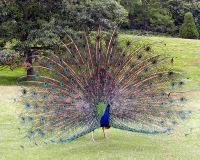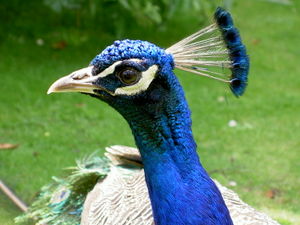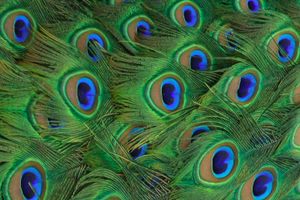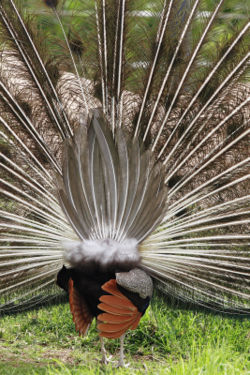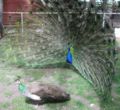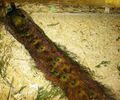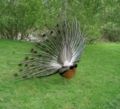Peafowl
2007 Schools Wikipedia Selection. Related subjects: Birds
| iPeafowl | ||||||||||||
|---|---|---|---|---|---|---|---|---|---|---|---|---|
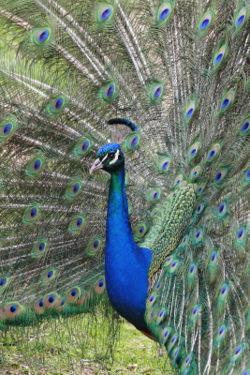 Indian Blue Peacock
|
||||||||||||
| Scientific classification | ||||||||||||
|
||||||||||||
|
|
||||||||||||
|
Pavo cristatus |
The term peafowl can refer to any of three species of bird in the genera Pavo and Afropavo of the pheasant family, Phasianidae. They are best known for the male's extravagant tail, which it displays as part of courtship. The male is called a peacock, the female a peahen. Although commonly used, peacock is an incorrect term to refer to both sexes.
The three species are:
- Indian Peafowl, Pavo cristatus (Asiatic)
- Green Peafowl, Pavo muticus (Asiatic)
- Congo Peafowl, Afropavo congensis (African)
Overview
The Asiatic peafowl genus Pavo includes the familiar Indian Peafowl or Indian Blue Peafowl and the much rarer Green Peafowl or Dragonbird. The Congo Peafowl is found in parts of Central Africa.
The Green Peafowl breeds from Myanmar east to Java. The IUCN lists the Green Peafowl as vulnerable to extinction due to hunting and a reduction in extent and quality of habitat.
Taxonomy
The two Pavo species will hybridize in captivity although their ranges in the wild are non-overlapping.
Some taxonomists believe that the endangered Green Peafowl is actually a complex of five distinct species although they are currently treated as one species with three subspecies .
The Congo species has many differences from the Pavo peafowl, but they are nevertheless its closest relatives.
Food
Peafowl are omnivorous and consume plant parts, flower petals, seed heads, insects, and other arthropods, as well as reptiles and amphibians.
Although possessing metatarsal spurs—"thorns" used for kicking, they are used only for defence against predators.
Habitat
Asiatic peafowl like the Indian Blue Peafowl and especially the Green Peafowl occupy a similar niche as the roadrunners, Secretary Bird, and Seriema. All of these birds hunt for small animals, minnows, and arthropods on the ground, in shallow streams and frequently in tall grass habitats. Small snakes and other reptiles are the preferred diet of wild peafowl.
Peafowl inhabit tropical savannah and riparian forests where they hunt for small animals in close social units of related birds that may span many generations.
Plumage
The male (peacock) has beautiful iridescent blue-green or green coloured plumage. The so-called "tail" of the peacock, also termed the "train," is in fact not the true tail but highly elongated upper tail coverts. The train feathers have a series of eyes that are best seen when the tail is fanned. Both species have a head crest.
The female (peahen) has a mixture of dull green, brown, and grey in her plumage. She lacks the long tail of the male but has a crest.
Females can also display their plumage to ward off danger to her young or other female competition.
Many of the brilliant colors of the peacock plumage are due to an optical interference phenomenon ( Bragg reflection) based on (nearly) periodic nanostructures found in the barbules (fibre-like components) of the feathers.
Different colours correspond to different length scales of the periodic structures. For brown feathers, a mixture of red and blue is required—one colour is created by the periodic structure, while the other is a created by a Fabry-Perot interference peak from reflections off the outermost and innermost boundaries of the periodic structure.
Such interference-based structural colour is especially important in producing the peacock's iridescent hues (which shimmer and change with viewing angle), since interference effects depend upon the angle of light, unlike chemical pigments.
Peackock Feathers are considered unlucky by actors.
Behaviour
The peafowl are forest birds that nest on the ground. The Pavo peafowl are terrestrial feeders but roost in trees. They are weak fliers.
Peafowl are considered to be polygamous. However in captivity, Green Peafowl and African Peafowl are monogamous, with males assisting in nest defense, chick rearing, and chick brooding. The male's bond with offspring may extend indefinitely. First-year chicks that have been weaned by their mothers generally join their father's social unit to forage and rest.
In Green Peafowl, it is impossible to distinguish juvenile and subadult green peafowls from their mothers and hence their polygynous nature is hard to establish. There is some anectodotal evidence suggesting that Green Peafowl may have very complex social lives that may include the adoption of one and two year old juveniles by their three and four year old sub-adult siblings.
Peafowl are unusual amongst the Galliformes in their capacity for sustained flight. All known genera of the peafowl family exhibit complex flight displays.
Each race of the Green Peafowl has its own respective wing shape and flight display behaviour. Green Peafowls in Java are often observed flying out to sea where the birds gather on islets some miles from shore.
African Peafowl have unusually large wings in relation to their weight. The wings have a highly unusual shape as well. The African Peafowl or Afropavo wing is prominently marked in both sexes in striking patterns and colours.
All known species of peafowl perch on emergent trees that stand above the canopy. Chicks of Indian Peafowl are sometimes carried on the backs of the parent birds as they fly into the security of a tree to roost.
Courtship
Although peafowl are capable of reproducing at the age of 2, peacocks do not reach full maturity until one year later. At the age of 2, the feathers are not fully developed in length and density. While peacocks at that age are physiologically able to mate with peahens, they have very little chance of competing with older peacocks with larger feathers. At the age of 3, peacocks' feathers reach maximum length for their lives, aside from the new feathers that grow after they molt in the late summer. The peacock can not begin to reproduce until the early fall.
Mating season starts in the early Spring and ends in the early Autumn. The peacock's courtship rituals include the display of its startling plumage and a loud call. Recent studies have shown that both the frequency and quality of sexual plumage displays by males are reliable indicators of the health status of an individual.
